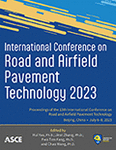Genetically Optimized BP Neural Network Based Alkali Inspired Material Proportioning Design
Publication: International Conference on Road and Airfield Pavement Technology 2023
ABSTRACT
Alkali-activated materials are significant functional materials widely utilized in industrial and technological sectors. They efficiently handle solid waste, reduce cement consumption, and play a crucial role in sustainable construction. However, due to their complex reaction mechanisms and differences from traditional cementitious materials, further research is necessary to explore optimal proportioning methods that fully harness their advantages. In this study, machine learning techniques were employed to rapidly and effectively design alkali-activated material mixtures. With a total of 47 samples, 27 were used for training and 20 for testing. The BP neural network model was optimized, and analysis using the random forest algorithm revealed that the CaO content contributes the most to compressive strength. This research provides novel insights and practical guidance for alkali-activated material proportioning, reducing experimental costs, and expanding the application of machine learning in the engineering field.
Get full access to this article
View all available purchase options and get full access to this chapter.
REFERENCES
Kumar S, Garcíatriñanes P, Teixeirapinto A. et al. (2013). “Development of alkali activated cement from mechanically activated silico-manganese (SiMn) slag.” Cement & Concrete Composites, 40(10):7-13.
Sun Jiaying, Zhu Peinan. (1988). “Mechanism of slag under alkaline solution excitation.” Silicate Bulletin, 17(6):16.
Li Guohao. (2022). “Study on the preparation of high-strength self-supporting zeolite by alkali-inspired gelling materials.” China General Research Institute of Building Materials Science.
Fernández-Jiménez A, Palomo J G, Puertas F. (1999). “Alkali-activated slag mortars: Mechanical strength behaviour.” Cement&Concrete Research, 29(8):1313-1321.
JTBAB. (1989). Present state and future of alkaliactivated slag concretes.
Al-Otaibi S. (2008). “Durability of concrete incorporating GGBS activated by water-glass.” Construction & Building Materials, 22(10):2059-2067.
Daniela E A, Ruby M G, Francisca P. (2017). “Alkali-activated Portland blast-furnace slag cement: Mechanical properties and hydration.”Construction and Building Materials, 140:119-128.
Liu Qian. (2022). “Experimental study on the residual mechanical properties of alkali slag concrete after high temperature.” Kunming University of Technology, China.
Yu Sheng. (2020). “Research on physical and mechanical properties of alkali-excited slag-fly ash colloidal body.” Hubei University of Technology, China.
Zhang, P Y (2022). “Study on alkali-excited cementitious materials of iron tailings-steel slag.” North China University of Technology, China.
Zhang, Bingxue. (2018). “Experimental Study on the Axial Compression Performance of Slag-Fly Ash/Metakaolin Ground Polymer Recycled Concrete.” Guangdong University of Technology, China.
Sun, Jianwei. (2019). “Performance of alkali-excited steel slag cementitious materials with concrete.” China University of Mining and Technology (Beijing).
Liu Qian, Ma Qianmin, Peng Xiao, Shi Yu, Long Yingbin, Liang Zhiqiang, and Miao Qinfeng. (2022). “Study on the effect of alkali exciter on the compressive strength of alkali slag concrete after high temperature.” New Building Materials, 49(02):70-74.
Liu, P., Fang, Chong. (2012). “Application of support vector machine in strength prediction of slag-fly ash concrete.” Science Technology and Engineering, 12(18):4549-4552.
Ji Tao, Lin Tingwei, Lin Xujian. (2005). “A method for predicting compressive strength of concrete based on artificial neural network.” Journal of Construction Materials, (06):677-681.
Liang, Kaixuan, Zhao, Gangxuan, and Zhang, Xuan. (2021). “Research on the prediction of compressive strength of alpine concrete based on BP neural network.” Anhui Architecture, 28(12):89-90.
Zhu Fan. (2022). “Ultrasonic rebound synthesis method based on improved GA-PSO-BP for measuring the strength of long-aged concrete.” Hebei Institute of Construction Engineering.
Li Ping. (2008). “Research on the Application of Multiple Intelligent Algorithms in Concrete Proportioning Optimization.” Science and Technology Information (Academic Research) (15):283-284.
Kuang, Xiangwen, Wang, Fang, Deng, Jiesong, Fu, Zhuangjin, Liu, Yating. (2023). “Analysis of concrete compressive strength prediction based on BP neural network.” Anhui Architecture, 30(01):67-69.
Song, Lingling. (2010). “Research on high performance concrete performance prediction and proportioning optimization based on evolutionary algorithm.” Hebei Agricultural University, China.
Hu, Dingyu. (2022). “Concrete Performance Prediction and Proportioning Design Based on Machine Learning and Optimization Algorithm.” Chongqing Jiaotong University, China.
Liu, Qing. (2022). “Simulation study of concrete proportioning design based on PSO-BP.” Journal of Changchun Normal University, 41(06):33-37.
Luo Guangbin, Hong Chengyu, Cheng Zhiliang, Su Dong. (2023) “Research on compressive strength prediction of concrete based on BP and GA-BP neural networks.” Concrete, (03):37-41.
Information & Authors
Information
Published In
History
Published online: Feb 6, 2024
ASCE Technical Topics:
- Alkalinity and acidity
- Artificial intelligence and machine learning
- Business management
- Cement
- Chemical properties
- Chemistry
- Compressive strength
- Computer programming
- Computing in civil engineering
- Concrete
- Construction wastes
- Engineering fundamentals
- Engineering materials (by type)
- Environmental engineering
- Material mechanics
- Material properties
- Materials engineering
- Models (by type)
- Neural networks
- Optimization models
- Pollutants
- Practice and Profession
- Solid wastes
- Strength of materials
- Sustainable development
- Wastes
Authors
Metrics & Citations
Metrics
Citations
Download citation
If you have the appropriate software installed, you can download article citation data to the citation manager of your choice. Simply select your manager software from the list below and click Download.
